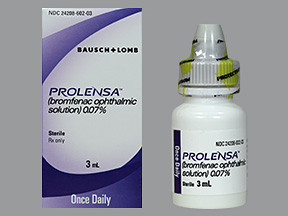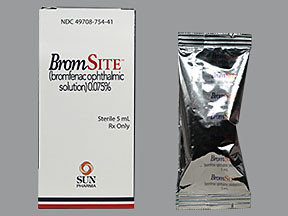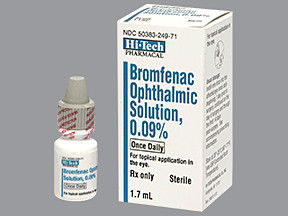BROMFENAC - OPHTHALMIC
PHONETIC PRONUNCIATION: (BROME-fen-ak)
COMMON BRAND NAME(S): Bromday, Prolensa, Xibrom
GENERIC NAME(S): bromfenac sodium
Uses
USES: This medication is used to treat swelling (inflammation) and pain in the eye after a certain type of eye surgery (cataract surgery). Bromfenac belongs to a class of drugs known as nonsteroidal anti-inflammatory drugs (NSAIDs). It works by blocking the effects of certain natural substances (prostaglandins) that cause pain and inflammation.
How to use BROMFENAC - OPHTHALMIC
HOW TO USE: Your doctor may direct you to start using this medication the day before or the day after your surgery. Place 1 drop into the affected eye as directed by your doctor, usually once or twice a day for 2 weeks. Carefully follow your doctor's specific directions. To apply eye drops, wash your hands first. To avoid contamination, do not touch the dropper tip or let it touch your eye or any other surface. This medication should not be used while wearing contact lenses. Consult your doctor or pharmacist for details. If you are wearing contact lenses, remove them before using eye drops. Tilt your head back, look upward, and pull down the lower eyelid to make a pouch. Hold the dropper directly over your eye and place 1 drop into the pouch. Look downward and gently close your eyes for 1 to 2 minutes. Place one finger at the corner of your eye (near the nose) and apply gentle pressure. This will prevent the medication from draining out. Try not to blink and do not rub your eye. Do not rinse the dropper. Replace the dropper cap after each use. If you are using another kind of eye medication (e.g., drops or ointments), wait at least 5 to 10 minutes before applying other medications. Use eye drops before eye ointments to allow the drops to enter the eye. Use this medication regularly in order to get the most benefit from it. To help you remember, use it at the same time(s) each day. Continue using it for the full time prescribed. Do not apply this medication more often than prescribed or continue using it for longer than directed by your doctor. Prolonged use of bromfenac eye drops may increase the risk of very serious side effects of the eye.
Side Effects
Precautions
Interactions
Overdose
Images
Reviews
Faq for BROMFENAC - OPHTHALMIC
Bromfenac ophthalmic is an eye medication that belongs to the class of nonsteroidal anti-inflammatory drugs (NSAIDs). It is used for the treatment of eye inflammation and pain following cataract surgery.
Bromfenac ophthalmic works by reducing the production of certain substances in the body that cause inflammation and pain. It blocks the action of an enzyme called cyclooxygenase (COX), which is responsible for the synthesis of these substances.
Bromfenac ophthalmic is typically used as eye drops. The recommended dose is one drop in the affected eye(s) once daily, starting the day before cataract surgery and continuing for two weeks after surgery. It is important to follow the instructions provided by your doctor.
Common side effects of Bromfenac ophthalmic include eye irritation, burning or stinging sensation, blurred vision, and sensitivity to light. Serious side effects such as eye swelling, eye pain, or changes in vision should be reported to a healthcare professional immediately.
The safety and effectiveness of Bromfenac ophthalmic have not been established in children. It is generally not recommended for use in pediatric patients.
It is usually safe to use other eye medications while using Bromfenac ophthalmic, but it is important to follow your doctor's instructions. Inform your doctor about all the medications you are using, including prescription and over-the-counter drugs.
Bromfenac ophthalmic should be used during pregnancy or breastfeeding only if the potential benefits outweigh the potential risks. It is important to discuss this with your healthcare provider before using the medication.
Bromfenac ophthalmic should be stored at room temperature, away from moisture and heat. Keep the bottle tightly closed when not in use. Do not freeze the medication.
No, Bromfenac ophthalmic is a prescription medication and cannot be purchased over-the-counter. It can only be obtained with a valid prescription from a healthcare professional.
Disclaimer
IMPORTANT: HOW TO USE THIS INFORMATION: This is a summary and does NOT have all possible information about this product. This information does not assure that this product is safe, effective, or appropriate for you. This information is not individual medical advice and does not substitute for the advice of your health care professional. Always ask your health care professional for complete information about this product and your specific health needs.



No Reviews Yet